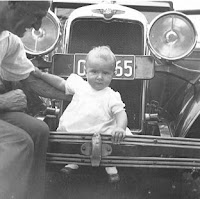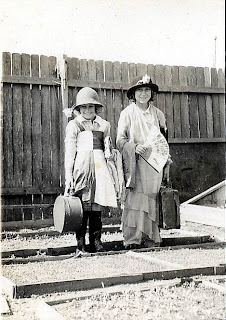Bert also had raisin sandwiches, banana sandwiches and bread and honey most days - certainly his own choice, not shared by anyone else in the household. He had a 'fizzy drink' each day after his evening meal - Alkasetzer - to aid his digestion. On weekdays Bert drove to work early. On his way home he often stopped to see Grace, still living in Mascot, and estranged from her mother.
Nell had the evening meal on the table at 5.00pm. If Bert was late, his meal was in the oven of the coal-fired stove. Bert was mostly home before 4.00pm, working in his shed. Just before 5 he would come into the house and wash-up in the large bathroom, scrubbing his hands with solvol, lathering again and again, pushing the lather down each hand until it was clean.
After the evening meal, he and Nell retired to the sitting room, in front of the radio. Nothing came between Bert and the radio serial, When a girl marries.
There were celebrations with the Harris's - their friends from the Orontes - or with Fred and Clare - around the pianola.
Bert had a permanent booking on Saturday nights at the Botany Empire Cinema - upstairs, first row on the right, a double seat. He and Nell rarely missed.
On weekends there were still the drives into the bush. Sometimes Nell would spot a plant in the scrub and call for Bert to stop. She would dash into the bush, dig up or snap off enough to try growing it in her bush-house. Bert still grew vegetables and flowers for home consumption and Nell kept chickens.
 Bert paid for Sylvia's two children to be born in the Pacific Private Hospital in Brighton-le-Sands, perhaps hoping to prevent his daughter having the difficulties that had plagued Nell's pregnancies.
Bert paid for Sylvia's two children to be born in the Pacific Private Hospital in Brighton-le-Sands, perhaps hoping to prevent his daughter having the difficulties that had plagued Nell's pregnancies. Bert badly wanted a grandson. When Sylvia's first baby, born in 1947 was a girl, Bert refused to look at her for a week, and called her 'Sonny Jim' for 16 months until Sylvia obliged with a boy.
Bert badly wanted a grandson. When Sylvia's first baby, born in 1947 was a girl, Bert refused to look at her for a week, and called her 'Sonny Jim' for 16 months until Sylvia obliged with a boy.
He was always kind to his granddaughters - but in his world a boy was what counted.
He had no time for women drivers, women in public life, or education for women.
 Albert's photography business thrived in the 1950s, leading to Albert becoming the photographer for Woolworths in Sydney, near the Town Hall. He had a small studio there were he took photos, which he developed in a darkroom near Central Railway. Irene learned to colour the photos and Beryl served as receptionist.
Albert's photography business thrived in the 1950s, leading to Albert becoming the photographer for Woolworths in Sydney, near the Town Hall. He had a small studio there were he took photos, which he developed in a darkroom near Central Railway. Irene learned to colour the photos and Beryl served as receptionist. |
| Grace and Brenda Grace |
Grace and Sid had a daughter, Grace Brenda, born in 1949. Sid worked at the Bunnerong Power Station, near the Botany Bay heads.
 |
| Bunnerong Powerhouse from Banksmeadow School 1940 |
In 1953 Sylvia and Len bought their own home in Livingstone Avenue Botany, the same street that the family had lived in when Bert worked on the Banksmeadow retaining wall. Bert and Nell drove over to visit on most Sundays, sometimes staying, sometimes taking everyone on the routine drive to the bush.

In the school holidays Nell and Bert would take Sylvia and her children on day trips to places like the Captain Cook landing place at Kurnell.
On the way home, Bert always stopped to buy ice-cream for everyone - vanilla between wafer biscuits.






-001.jpg)










































